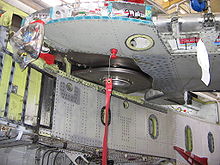Swivel vane

Swivel blades are wings whose sweep can be changed by a swivel mechanism.
function
Depending on the design, either the entire wing or only parts of the wing are pivoted. The aerodynamic drag and the buoyancy of the structure can be adapted to the respective flight speed and operating conditions. At low speed or during take-off and landing, the surfaces are set to a low sweep, which means that high lift can be generated despite the low speed. Take-off and landing speeds can be reduced and maneuverability in slow flight is also improved. During fast flight, the sweep is increased, which reduces the air resistance of the aircraft and thus enables greater speed and range.
The sweep is only the most obvious part. From an aerodynamic point of view, it is particularly important that the wing extension and the profile depth can also be changed by pivoting . The latter arises from the fact that the profile chord is lengthened by pivoting back (viewed in the direction of flow) while maintaining the same thickness of the wing .
A special form of the swivel wing is the oblique wing concept, in which a continuous wing is swiveled around a central pivot point. Tilt rotor aircraft, which instead of the rotor nacelle can pivot the entire wing upwards (e.g. the Hiller X-18 ), are also often referred to as tilt-wing aircraft. The correct name for this is tilt wing aircraft .
The swivel- wing wing should also not be confused with the gull wing ("seagull wing") and the foldable wings of carrier aircraft , which are used to save space on the decks of aircraft carriers.
history
Today, the prototype of the Messerschmitt P.1101 is considered to be the first swivel-wing aircraft , the wings of which were adjustable on the ground in a range of 35 ° -45 °. After the aircraft fell into American hands as spoils of war towards the end of the Second World War , the Bell X-5 was developed on the basis of this aircraft , which had swivel wings that could be adjusted in flight.
Advantages and disadvantages
Swivel wings offer advantages when high demands on slow flight behavior, runway length, payload capacity and, at the same time, on flight at very high speeds ( supersonic capability , e.g. when penetrating the enemy airspace or during interception maneuvers) are to be combined in one airframe. Disadvantages arise compared to fixed wing constructions due to the increased curb weight and the complexity of the swivel mechanism.
The advent of relaxed stability control systems in the 1970s eliminated many of the disadvantages of fixed wing systems. No new swing-wing aircraft has been built since the Tupolev Tu-160 , but it is noteworthy that the successor system to the Grumman F-14 - the F / A-18E / F - has a reduced payload / range capability due to its small fixed wing.
Alternative solutions
With the North American XB-70 the wings - more precisely: the wing tips - were not swiveled horizontally, but vertically. From about Mach 1.8, both wing tips were folded down to a maximum of 65 °.
Swivel-wing aircraft produced in series
| Type | Usage | Year of construction from | Year of construction to |
|---|---|---|---|
| General Dynamics F-111 | Medium-range fighter-bomber / strategic bomber / reconnaissance aircraft |
1967 | 1982 |
| Mikoyan-Gurevich MiG-23 | Hunter / fighter-bomber | 1967 | 1985 |
| Rockwell B-1 A | long-range strategic bomber | 1970 | 1977 |
| Mikoyan-Gurevich MiG-27 | Fighter bomber | 1970 | 1986 |
| Sukhoi Su-17 / Su-20 / Su-22 | Fighter bomber | 1970 | 1990 |
| Sukhoi Su-24 | tactical bomber | 1971 | 1974 |
| Tupolev Tu-22M | bomber | 1972 | 1993 |
| Panavia tornado | Multipurpose fighter | 1973 | 1999 |
| Grumman F-14 | Air superiority fighter | 1972 | 1992 |
| Rockwell B-1 B | long-range strategic bomber | 1981 | 1988 |
| Tupolev Tu-160 | long-range strategic bomber | 1984 | 1994 |
| Tupolev Tu-160 M | long-range strategic bomber | 2001 | still in production |
Web links
Individual evidence
- ↑ Bob Kress, Paul Gilcrist: Battle of the Superfighters - F-14D Tomcat vs. F / 18 E / F Super Hornet . In: Flight Journal Magazine . February 2002 ( online ( memento from April 4, 2009 in the Internet Archive ) - "[...] it has only 36 percent of the F-14's payload / range capability"). Battle of the Superfighters - F-14D Tomcat vs. F / 18 E / F Super Hornet ( Memento of the original from April 4, 2009 in the Internet Archive ) Info: The archive link was inserted automatically and has not yet been checked. Please check the original and archive link according to the instructions and then remove this notice.

